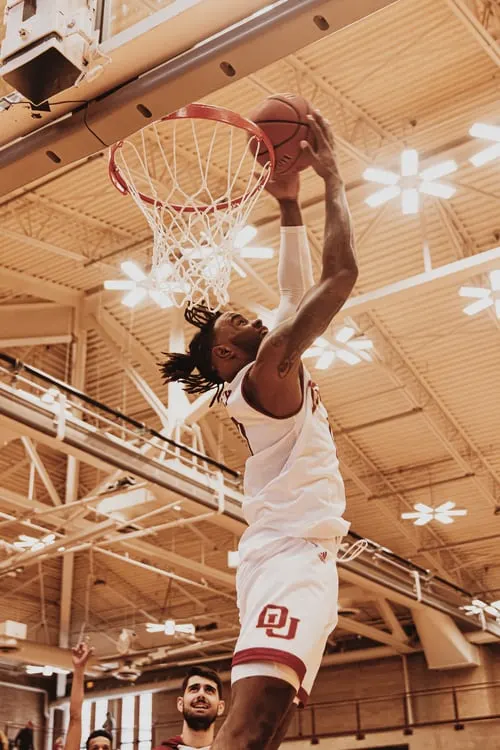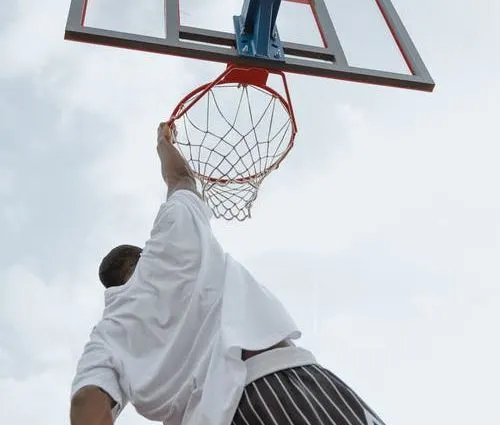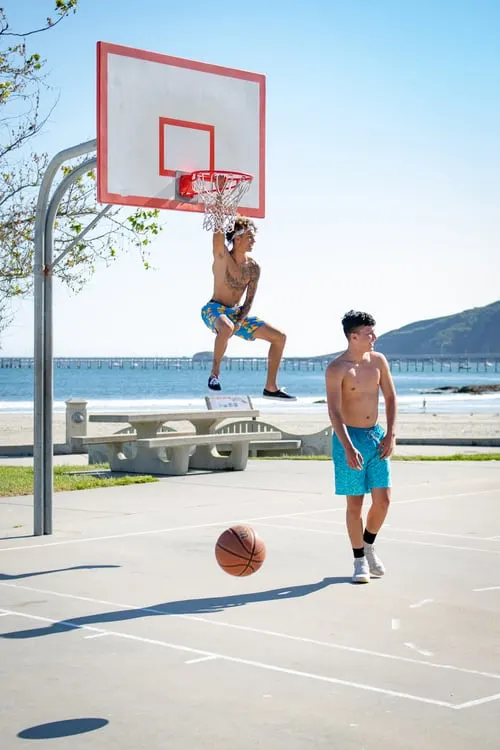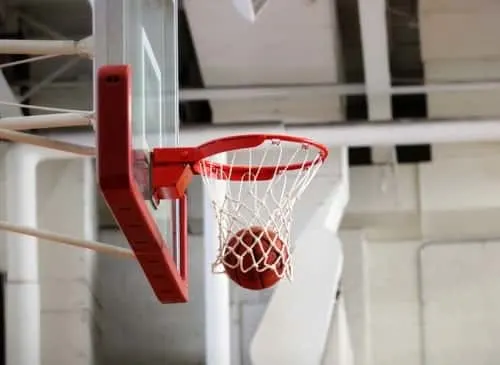As a fan and enthusiast, nothing in the sport of basketball seems more entertaining than a player dunking the ball. If a player draws contact or dunks on another player, even better. You would then expect the player to be able to protect themselves by hanging on the rim.
So Why then can’t a player hang on the rim after dunking the basketball? In basketball, a player is not allowed to excessively hang on the rim. In doing so they would receive a technical foul. A player can only hang on the rim for safety purposes and must only do so for the time that is needed to safely land without injury.
The reality is when a player dunks the basketball and they are at the rim with players beneath them, their main concern is coming down safely. A technical foul is issued through the discretion of the referee.
If you are thinking about buying a basketball jersey or shoes, check out the offers below from these retailers.
| Retailer | Promo Code | Promotion | Link to Retailer |
 | DROP | 70% OFF | Go to Fanatics |
 | PARSCR20 | 20% OFF | Go to Eastbay |
 | N/A | N/A | Go to Amazon |
Technical foul for hanging on the rim? Rule
It is a technical foul for hanging on the rim and a foul shot and possession of the ball is awarded to the other team.
We are going to use the NBA rule book to take a look at why players are not allowed to hang on the rim.
According to the NBA rule book, there are two types of technical fouls that a player can receive. The first is unsportsmanlike and the second non-unsportsmanlike.
Unsportsman Like Technical Fouls
- Taunting.
- Swearing.
- A bench player goes onto the court during play.
Non-Unsportsmanlike Technical Fouls
- Too many players on the court.
- Excessive timeouts.
- Delay of game.
Hanging on the rim is considered a non-unsportsmanlike technical foul. In the event of a technical foul the team will be awarded two free throws and possession of the basketball.
Section IV—Basket Ring, Backboard or Support
- An offensive player who deliberately hangs on his basket ring, net, backboard or support during the game shall be assessed a non-unsportsmanlike technical foul.
- A defensive player who deliberately gains or maintains height or hangs on his opponent’s basket ring, net, backboard or support shall be assessed a non-unsportsmanlike technical If he touches the ball during a field goal attempt, points shall be awarded consistent with the type of shot.
- EXCEPTION: An offensive or defensive player may hang on the basket ring, backboard or support to prevent an injury to himself or another player, with no technical foul assessed.
- Should a defensive player deliberately hang on the basket ring, net, backboard or support to successfully touch a ball which is in possession of an opponent, a non- unsportsmanlike technical foul shall be assessed.
In my opinion, hanging on the rim should be considered taunting if anything and should fall under unsportsmanlike, but really it doesn’t matter as all technical fouls result in the same number of shots.
The rule altogether is unnecessarily governed way too intensely during a game. The reality is when a player goes up to dunk the basketball they are more concerned about how they are going to get down without landing on anyone’s foot (twisting an ankle) than being above the rim and showboating.
This rule is too policed by the referees and should be relaxed. The rule should allow the player to hang as long as needed so that the player can get down safely, without having to worry about how long they should hold on to the basketball ring for.
As long as a player doesn’t pull themselves up on the rim or yell out any comments towards the other team the rule should allow for more time for the player to hang. There are times when a player has hung on the rim without any bad intentions and received a technical foul.
When are you allowed to hang on the rim? After a dunk?
In basketball players use speed and quickness to score baskets. Dunking the basketball requires explosive power, to do so this sometimes requires a player to dunk the basketball by jumping high and getting to the rim as quickly before the defense is able to get into position to defend.
Depending on how fast or quick a player is moving towards the hoop for a dunk, the player will hang on the rim because their body is in full swinging motion. Think of a child swinging from the monkey bars on a play ground.
Players will hang and hold on to be safe and prevent any injury on the way down especially if there is contact upon dunking.
The referee will use their judgment and determine if a player is needing to hang on the basketball hoop in order for the player to protect themselves. I this is the case no technical foul is called.
Again if a player drawers enough contact or the player feels as if they will lose their balance or has a legitimate reason to hang as needed in order to protect themselves, they should do so without worry.
 Do Basketball Leagues need this rule?
Do Basketball Leagues need this rule?
Now let’s take a look at why the rule is in place from the NBA perspective. If the rule was uplifted today and done away with, immediately you would have a lot of players hanging far longer than they need to.
For example, during pick-up basketball around the world, many players who dunk the basketball are always giving something extra. Whether that is pulling themselves way over the rim or slapping the backboard hard on the way down, they are looking for a reaction.
This is a way players try to trash talk or intimidate other players. Call it showboating taunting and everything in between.
If the rule was not in place in the NBA this is what you would see and many more fights would happen because of it.
Will the rim break from dunking or hanging on it?
Ever since the days of Shaq in the early 1990s basketball rims have been tried and tested and are built extremely strong and weight-bearing especially for guys like Shaq. For starters they are made of high-grade steel and are spring loaded.
Spring-loaded allows for players to hang on the rim without bending it or damaging it.
Most hoops can easily hold Shaq. The basketball hoops you see in college and professional leagues are durable and will last a lifetime without any issues.
They would be checked for maintenance but usually, no major repairs are needed.
The hoops that you see in high school and some college gyms where their frame and its structure hang from the roof of the gym are only as strong as there structure.
Some basketball hoops are mounted to the frame that pulls out from the wall. Most basketball hoops are able to withstand the forces of a dunk.
There are many different basketball goals on the market that are built to last but the reality is not every hoop does.
No dunk Rule
This is why many high schools and senior men’s basketball leagues will have a no dunking rule.
Usually, in the high school in men’s leagues, I have been a part of there are often times that a rule that is enforced is no dunking or hanging on the rim rule during warm-up.
This rule seems to be violated during halftime when players are warming p for the second half. Players often try to attempt a dunk or grab the rim to impress their friends.
The reason for this rule in place is because the school can’t afford to replace the rims or doesn’t have an extra hoop on site.
In conclusion, most players in the NBA can dunk the basketball. But dunking in games is not as easy as it sounds and requires speed and explosive power.
Just ask J.J Reddick who has only dunked once in his 15 year NBA career, for a player that averages 12 points a game that should say something. Let them Hang.




